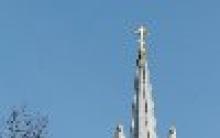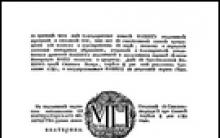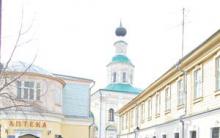Travel by public transport: from Moscow from Yaroslavsky station to Pushkino station - 31 km, then by bus to Krasnoarmeysk to Tsarevo - 18 km.
Travel by car: From Moscow along the Yaroslavskoe highway to A-107 (Small Moscow Ring), then turn right onto A-107, get to the roundabout (6 km), turn left in a circle to Krasnoarmeysk, drive another 2 km to Tsarevo.
St. Nicholas Church in the village of Tsarevo was built in 1812-1815 in a village that belonged to the Durasov nobles. The author of the project was, in all likelihood, the Moscow architect Ivan Vasilyevich Egotov, a student of V.I. Bazhenov and M.F. Kazakov. Unfortunately, no drawings with his signature have been preserved, but due to a number of features of the temple, and the fact that Egotov had recently built a manor house in Lyublino for the owner of the village, Nikolai Alekseevich Durasov, researchers are confident of his authorship here.
At that time, Tsarevo was a small village of 24 households. However, Durasov decided to build a magnificent temple here, and dedicated one of the chapels to the martyr Agrippina in memory of his mother, Agrippina Ivanovna Durasova, who acquired this village from Prince Shcherbatov in 1774. Some sources claim that the St. Nicholas Church in Tsarevo was built by A.I. Durasova, but this can hardly be true, since the princess died 25 years before the start of construction work in Tsarevo.
The village of Tsarevo is quite ancient. Mentions of it can be found already in the 16th century, although at that time the village was called Ievlevo. It is known that the road to Alexandrov led through it, and in 1564 Ivan the Terrible stayed here. Tradition says that the royal son from Ivan the Terrible's second wife, Circassian princess Maria, who died at the age of 1 or 2 years, was buried here on the way, and a chapel was first erected over his grave, and later a wooden temple. Although historians argue that it is unlikely that the young son of Ivan the Terrible would have been buried in a remote village along the road. There is information that the current name of the village was given by the name of one of the first known owners, Ivan Markovich Tsarev.
 In the 17th century, the village was again mentioned in scribe books, indicating the tented wooden church of St. Nicholas the Wonderworker with two chapels. The current stone church was built in its place. At that time, the village belonged to N.I. Sheremetev, who kept a courtyard here.
In the 17th century, the village was again mentioned in scribe books, indicating the tented wooden church of St. Nicholas the Wonderworker with two chapels. The current stone church was built in its place. At that time, the village belonged to N.I. Sheremetev, who kept a courtyard here.
Later Tsarevo passed to F.A. Golitsyn, and by the middle of the 18th century. − P.N. Shcherbatov. He sold the village to the Durasovs, who owned the local lands for quite a long time, until the middle of the 19th century.
The building of the St. Nicholas Church is truly magnificent; it is built in the majestic style of Russian Gothic, or neo-Gothic, popular in the 18th century and at the beginning of the 19th. The massive main volume of the temple, consisting of a quadrangle and a large wide rotunda, is crowned by a dome and an octagon, on which five spiers are placed instead of domes. The central spire is tall, the four side spires tightly pressed to it are smaller. All of them were topped with crosses, but today only one central cross has survived. The rotunda is also decorated with small spiers around the circle. Against the background of the huge rotunda, a small bell tower, also topped with pointed ends with crosses, is almost invisible. Symmetrically to the bell tower, on the eastern side, above the altar part, the same turret was erected (the influence of classicism with its commitment to strict symmetry is evident).
A wide, beautiful frieze of bas-reliefs by sculptor Gavriil Tikhonovich Zamaraev looks somewhat unusual on a Gothic temple. The frieze figures depict various scenes from the Gospel. Under the wide classic frieze there is another one - an arcature one, in the Gothic style.
- Inside the temple is impressive with its space.
- The huge main volume is magnificently illuminated by the high windows of the rotunda and the lower tier; the preserved ancient iconostasis with beautiful carvings and icons looks majestic. The paintings on the walls of the temple also survived, since it was practically not closed even in Soviet times. The side chapels are very nice, made in the classicist style, with massive columns on the sides of the iconostasis. Recently, the dilapidated Holy Gate was restored, decorated in the same style as the temple - with five spiers.
- Operating, open.
- Located 33 kilometers northeast of the Moscow Ring Road.
- "Komsomolskaya", "VDNKh" - st. metro for transfer to public transport.
- Types of burial: in the ground, an urn with ashes or a coffin.
- Places are provided for related subburials and reserved for family (ancestral) graves.
- Open seven days a week: in October-April - from 9.00 to 17.00, in May-September - from 9.00 to 19.00. Throughout the year, funerals take place from 9.00 to 17.00.
- Coordinates 56.086167399188,38.093648068787.
A small rural cemetery in the Moscow region - Tsarevskoye - is located in a wooded area. Two hundred meters from the territory allocated for the Tsarevskoe cemetery, there is the Church of St. Nicholas the Wonderworker, built in the 19th century. The control of the activities carried out by the Tsarevskoe cemetery is carried out by the municipality of Domodedovo.
Why do you need an agent website?
saving up to 20,000 rub.
Protects relatives from possible unlawful actions of emergency services employees 102 and 103
Protects against black agents (fraudsters)
Will tell you about existing benefits provided by the state
He will advise you on the procedure and help you save the time you can devote for memories and preparation for farewell

saving up to 3,000 rub.
Transportation to morgue website
Offers free and 24-hour transportation to partner morgues: MEDSI, Burdenko and Odintsovo hospitals
Will advise on the cost of services in morgues

saving up to 7,000 rub.
Eliminates unnecessary visits to the morgue
Will advise on a guaranteed list of free morgue services
Protects against imposition of unnecessary paid services
Controls the quality of services provided by the morgue

saving up to 30,000 rub.
Will advise on options for providing a free burial place
If you want to purchase a place in the cemetery, he will offer options and verify the correctness of their cost within the framework of state-approved prices
Will protect against the imposition of additional unnecessary services by cemetery employees
During transportation
At the cemetery
How to get to Tsarevsky cemetery
If you are heading from Moscow to Krasnoarmeysk (Pushkinsky district), or vice versa, then be sure to go through the village. Tsarevo. And you will have an excellent opportunity to see the majestic and rather unusual St. Nicholas Church (1812), standing on the side of the road. It's impossible not to notice her!
Rumor and various historical sources claim that the first mention of the village of Tsarevo (or Ievlevo is an outdated name) and its owner T. Tsarev dates back to 1503-1504. And starting from the end of the 17th century. the village was owned by the Sheremetyevs, Golitsyns, Shcherbatovs, Durasovs, Zakrevskys.
On the site of the current stone church there was a wooden one and also had the name Nikolskaya. It was with the side chapels of St. Martyrs Paraskeva and St. Martyr Eliazar.

The Durasovs, having taken possession of the estate, turned to Bishop Augustine of Dmitrovsky with a request for permission to build a stone church in the name of St. Nicholas the Wonderworker. As you can see, the request was granted. Thanks to this, to this day we can admire a wonderful example of pseudo-Gothic architecture.

Address: Moscow region, Pushkinsky district, village of Tsarevo.
By car: from Moscow along the Yaroslavskoe highway to the turn to Krasnoarmeysk, then along this road to the village. Tsarevo
By bus: from Moscow from metro station "VDNKh" bus. No. 317;
By train: from Yaroslavsky station to Krasnoarmeysk, then bus. No. 21 to Tsarevo.
At that time, Tsarevo was a small village of 24 households. However, Durasov decided to build a magnificent temple here, and dedicated one of the chapels to the martyr Agrippina in memory of his mother, Agrippina Ivanovna Durasova, who acquired this village from Prince Shcherbatov in 1774. Some sources claim that the St. Nicholas Church in Tsarevo was built by A.I. Durasova, but this can hardly be true, since the princess died 25 years before the start of construction work in Tsarevo.
Village Tsarevo- quite ancient. Mentions of it can be found already in the 16th century, although at that time the village was called Ievlevo. It is known that the road to Alexandrov led through it, and in 1564 Ivan the Terrible stayed here. Tradition says that the royal son from Ivan the Terrible's second wife, Circassian princess Maria, who died at the age of 1 or 2 years, was buried here on the road, and a chapel was first erected over his grave, and later a wooden temple. Although historians argue that it is unlikely that the young son of Ivan the Terrible would have been buried in a remote village along the road. There is information that the current name of the village was given by the name of one of the first known owners, Ivan Markovich Tsarev.
In the 17th century, the village was again mentioned in scribe books, indicating the tented wooden church of St. Nicholas the Wonderworker with two chapels. The current stone church was built in its place. At that time, the village belonged to N.I. Sheremetev, who kept a courtyard here. Later Tsarevo passed to F.A. Golitsyn, and by the middle of the 18th century. − P.N. Shcherbatov. He sold the village to the Durasovs, who owned the local lands for quite a long time, until the middle of the 19th century.
The building of the St. Nicholas Church is truly magnificent; it is built in the majestic style of Russian Gothic, or neo-Gothic, popular in the 18th century and at the beginning of the 19th. The massive main volume of the temple, consisting of a quadrangle and a large wide rotunda, is crowned by a dome and an octagon, on which five spiers are placed instead of domes. The central spire is tall, the four side spires tightly pressed to it are smaller. All of them were topped with crosses, but today only one central cross has survived. The rotunda is also decorated with small spiers around the circle. Against the background of the huge rotunda, a small bell tower, also topped with pointed ends with crosses, is almost invisible. Symmetrically to the bell tower, on the eastern side, above the altar part, the same turret was erected (the influence of classicism with its commitment to strict symmetry is evident).
A wide, beautiful frieze of bas-reliefs by sculptor Gavriil Tikhonovich Zamaraev looks somewhat unusual on a Gothic temple. The frieze figures depict various scenes from the Gospel. Under the wide classicist frieze there is another one - an arcature one, in the Gothic style.
Village TsarevoStory. According to legend, in December 1564, Tsar Ivan the Terrible, on his way to Aleksandrovskaya Sloboda, stopped in the village. Ievlevo, later renamed Tsarevo. There, his wife Maria Temryukovna allegedly gave birth to a son, Vasily. The baby died and was buried in the temple. To this day, a crypt has been preserved on the southern side of the temple, which is called the burial place of the king’s son. The scribe book for 1624 indicates the presence in the village. Ievlevo is an elegant tented church with two chapels.
In 1812-1815 The current St. Nicholas Church was built at the expense of the owners of the Durasov village. Presumably, the author of the project was I. Egotov, a student of V. I. Bazhenov. The building is red brick, richly decorated with white stone, and is a significant monument of pseudo-Gothic architecture in the Moscow region. The main volume of the temple is a rotunda, completed by a massive light drum resting on eight abutments. The dome is crowned with a faceted tribune with a spire and four pinnacles. A similar composition completes the small belfry built above the vestibule. The facades of the building, dissected by highly elongated columns, are surrounded by a high-relief frieze of biblical scenes by sculptor T. Zamaraev. The chapels of the temple were consecrated: in the name of the prophet Elijah and MC. Agrippina. The four-tier iconostasis is contemporary with the temple.
Oil painting on the walls and vaults of the temple - second half of the 19th century. The temple was practically never closed. Currently, the church operates a Sunday school, a library, and the parish publishes the newspaper “The Road to the Temple.”











Chicken skewers Chicken skewers with bacon
Mushroom glade salad with honey mushrooms recipe with photos How to prepare mushroom glade salad with honey mushrooms
Very tasty lecho: recipe with carrots
Minced meat for dumplings - preparing hearty meals at home
Honey cake with sour cream